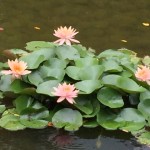Species:
English Name: Water-lily
Chinese Name:
Family: Nymphaeaceae
Description:
An aquatic species vastly used as an ornamental plant. They are mostly rhizomatous perennial herbs, sometimes with stolons. The leaves grow on long petioles from the rhizome. They float on the surface of the water, with the flowers rising from it. Each has at least 8 petals in different color shades (white, yellow, pink or blue).
They are pollinated by insects, often beetles.

Photos used under a Creative Commons license
References:
– Atlas of Common Harmful Freshwater Algae in Macau (2011), written by Qiu Yi Jian, Ung Wai Kin, and Kong Yi Jun, Editor-In-Chief: Fan Xiao Jun, Macau University of Science and Technology Publishing, ISBN: 978-99937-53-24-7

